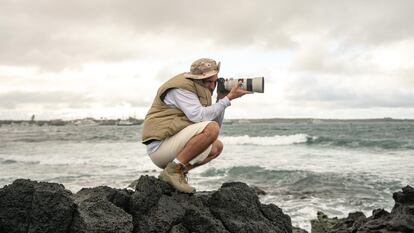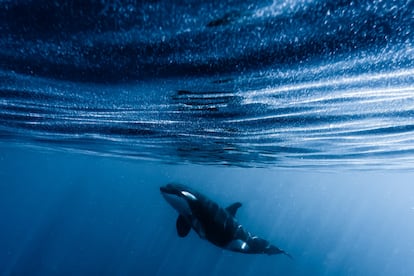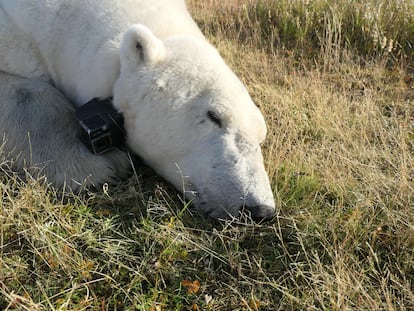An Argentine following in Darwin’s footsteps
One of the best nature photographers in the world, Nicolás Marín Benítez, is taking part in an expedition that aims to train leading ecologists from around the globe

At the age of seven, Nicolás Marín Benítez watched natural history documentaries on television and imagined what life was like for the divers who descended to the depths of the ocean, or for scientists who traveled to the desert or entered the jungle to share their knowledge about endangered species.
The year was 2005 and he could not have imagined then that, less than two decades later, he would be entrusted with missions around the world to document some of the most exotic animals and ecosystems on the planet, nor that this would earn him the distinction of being the best nature photographer in the world.
Since December, he has been part of Darwin 200, a project in which a large group of young people have traveled the same route as the British naturalist Charles Darwin aboard a 107-year-old boat, with the aim of being trained as leaders in conservation.
Marín Benítez, 24, grew up in San Miguel, a city in the province of Buenos Aires that is far from the sea, the jungle, or the desert islands that in the fullness of time would become his natural habitat. As a child, and until he was 18, he had always dreamed of playing professional tennis. “I was doing well. I competed in tournaments in the country, traveled throughout Latin America, and I went to the United States. But at 18, I started to question myself. I knew that there was only one Nadal, one Federer, one Djokovic. I was afraid for my future, and I started taking courses in photography, film, and writing. I didn’t study for a degree, but I enrolled in a school for creatives,” he recalls in an interview with EL PAÍS.
Travel the world on expeditions
A year later, he received a job offer to work as an underwater photographer in Cozumel, Mexico, focusing on marine life and coral reefs. There he received his first instruction as a diver. “I started taking photos underwater, but I wanted to blend it with science, and then I added my interest in environmental activism on top,” he says. Later, expeditions to photograph marine fauna in other areas came about, and Marín Benítez always made it his aim to spread the word of how environmental problems affect society. “My work has a more genuine look. It is connected with love and nature, and it tries not to be a mere spectator, but to provide a solution,” he says.
In November 2023, Marín Benítez was honored as Best Environmental Photographer of the year, in the “Recovering nature” category. The award comes from the Chartered Institute of Water and Environmental Management, which highlights the most inspiring environmental photographs in the world. When he sent a photo of a coral glowing in the dark, he explained to the jury that he used special diving lights “that don’t bother the animals.” He later said that, in the absolute darkness of the seabed, he saw the glow of the coral “as if it were a Christmas tree.” Although he was brimming with excitement, the environmentalist did not travel to London to receive the award. Instead, another challenging mission awaited him.
Following in Darwin’s footsteps
At the end of 2023, Marín Benítez planned to return to Argentina to visit his family after two years living in Baja California, Mexico. He was working on a documentary in Aruba, in his role as climate ambassador to the United Nations, when he was invited to join Darwin 200. The initiative brings together 200 environmentalists between the ages of 18 and 25 from all over the world who will spend two years traveling the same route that the famous British naturalist took.
At the beginning of the 1830s, Darwin embarked on a mission that spanned five years, traveling through America and Oceania. He made all kinds of scientific observations that led him to write his Research Diary and, decades later, to present his theory of the evolution of species and natural selection in The Origin of Species, published in 1859.
To mimic the sea voyage — which will continue until 2025 — the 107-year-old Dutch schooner Oosterschelde will stop at all the major ports where Darwin made landfall. In addition, it is scheduled make 50 one-week stays during the expedition.
There are young experts in giant turtles, marine plastics, reptiles, coastal habitats and reefs, among others. In total, there are eight research projects: four that will be carried out while at sea and another four to be carried out on land. Among them are measuring the evolution of the planet’s temperature, the advance of microplastics, the health of coral reefs, and research into new solutions to address pollution.
The Argentine photographer joined the expedition in Fernando de Noronha, Brazil. The goal was to be on board for just a week. First he had to photograph sharks, a creature with which he already had experience. In 2021 he documented whale sharks in Isla Mujeres, Mexico. “I had never seen an animal that big. They were 12 meters long, like a five-story building,” he says. Then he traveled to photograph sea turtles as part of a species conservation project. Afterwards, he returned to Argentina, stayed a few days on dry land and rejoined the Darwin 200 mission in Puerto Madryn in Río Negro province. The goal then was to travel to the Falkland Islands and other archipelagos in the South Atlantic to photograph and document penguins and albatrosses.
“The objective is to recreate Darwin’s route for two years and train 200 young people. In the Falklands I focused on photographing the population of king, rockhopper, and Magellanic penguins,” the photographer and ecologist explains. “I learn a lot, and every day it motivates me to think that I don’t know what I’m going to find, what’s going to come, but I’m sure it’s going to be something incredible.”

From travel logs to social media
That section of the trip, however, was the most difficult. He had to face storms at sea, violent waves seven meters high, and gale force winds that shook the sailboat. Marín Benítez says that the fear and adrenaline of the first few days in the Patagonian Sea dissipated as time went by.
The young explorer recorded his journey on social media with videos and images of his day to day life in the style of sea logs. In addition to documenting species, his role in Darwin 200 is to communicate the importance of fauna in the ecosystem, explain why species should be conserved, and detail the difficulties they face globally. For example, “ghost” fishing nets and other plastic waste found on the shores of the Falklands coast were an aspect that caught his attention when walking in the archipelago.
Marín Benítez celebrated Christmas 2023 on the high seas and the new year in the Falklands. He also visited Argentine memorial sites connected to the 1982 conflict, such as Darwin Cemetery, where the remains of those who fell in combat are buried, and the trenches, where some of the young Argentine soldiers’ personal effects are still preserved. “Being in the Falklands was magical. It has a double weight: it is a special place for nature, but there is also the weight of history, of the boys who went to war, which is very hard,” he explains. However, he believes that, in a context of climate change, the Falklands are a place of hope. “There is the largest albatross reserve and it is an oasis for whales,” he adds.
“My favorite mission is always the one that is yet to come, because there is a surprise factor,” he summarizes with a smile that lights up his face. “Now I want to return to live in Argentina to bring everything I learned to my country. In the future I see myself having the same adrenaline as always, being surrounded by nature, and perhaps being a force for a better world,” he says. And he leaves to look for a new adventure.
Sign up for our weekly newsletter to get more English-language news coverage from EL PAÍS USA Edition
Tu suscripción se está usando en otro dispositivo
¿Quieres añadir otro usuario a tu suscripción?
Si continúas leyendo en este dispositivo, no se podrá leer en el otro.
FlechaTu suscripción se está usando en otro dispositivo y solo puedes acceder a EL PAÍS desde un dispositivo a la vez.
Si quieres compartir tu cuenta, cambia tu suscripción a la modalidad Premium, así podrás añadir otro usuario. Cada uno accederá con su propia cuenta de email, lo que os permitirá personalizar vuestra experiencia en EL PAÍS.
¿Tienes una suscripción de empresa? Accede aquí para contratar más cuentas.
En el caso de no saber quién está usando tu cuenta, te recomendamos cambiar tu contraseña aquí.
Si decides continuar compartiendo tu cuenta, este mensaje se mostrará en tu dispositivo y en el de la otra persona que está usando tu cuenta de forma indefinida, afectando a tu experiencia de lectura. Puedes consultar aquí los términos y condiciones de la suscripción digital.
More information
Archived In
Últimas noticias
Pinochet’s victims grapple with José Antonio Kast’s rise in Chile
Reinhard Genzel, Nobel laureate in physics: ‘One-minute videos will never give you the truth’
Half of Scotland is in the hands of 420 property owners
From digital curfews to blocking apps: How technology experts protect their children online
Most viewed
- Pablo Escobar’s hippos: A serious environmental problem, 40 years on
- Reinhard Genzel, Nobel laureate in physics: ‘One-minute videos will never give you the truth’
- Why we lost the habit of sleeping in two segments and how that changed our sense of time
- Charles Dubouloz, mountaineering star, retires at 36 with a farewell tour inspired by Walter Bonatti
- The Florida Keys tourist paradise is besieged by immigration agents: ‘We’ve never seen anything like this’










































